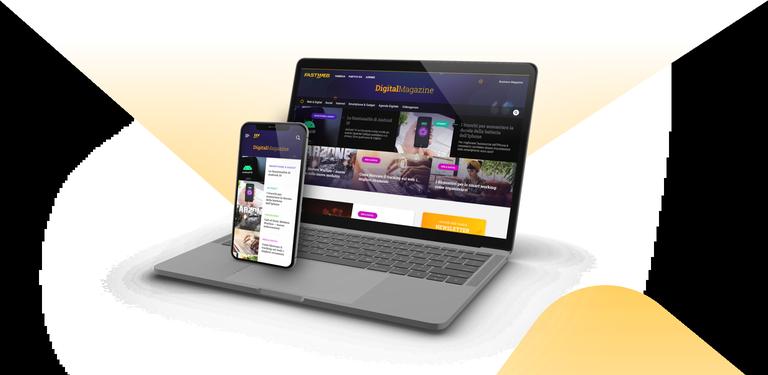Android smartphone screens, even those above 6 inches, sometimes stand a little tight and you feel the need to display some content on a larger and more comfortable screen. This is the main reason why the "mirroring" was invented, that is, the ability to bring on an external screen, whether that of a PC or a television, what we are viewing on the phone.
The whole thing, however, without using cables because otherwise it would be uncomfortable. With wireless mirroring, for example, we can view slides on a TV screen that a colleague emailed us after we left the office. In a case like this you Don't have to go to your home PC: just mirrored and we can see that file on the big TV screen, maybe from the couch.
Through mirroring, we can also have fun playing a mobile video game with a bigger screen. Or watch YouTube videos on TV. Mirroring on PC and TV, though, is not exactly the same and there are several ways to do both types of mirroring. Here are the simplest ones, with all their pros and cons.
Android mirroring on PC: the app your Phone
If the computer we want to connect your Android phone to is a PC with Windows 10, then the first attempt we should make with Microsoft's your Phone (your Phone) app. This app can also do much more than just mirroring, but let's focus on it.
After installing the application both on your smartphone and on your PC (the smartphone one is called "completion of your telephone"), we will have to launch it on your computer and connect the smartphone via a wizard, which requires the reading of a barcode. Unfortunately the "Phone screen" feature that allows mirroring from Android to Windows PC is only supported on some Samsung devices. Microsoft promises that soon all Android devices will be compatible, in the meantime you can see the list of smartphones compatible with Microsoft your Phone.

Se il dispositivo è compatibile, ed è connesso alla stessa rete Wi-Fi del computer, possiamo andare avanti con la configurazione e usare il mirroring. Sarà possibile anche usare mouse e tastiera per interagire con le app del telefono. Basta aprire l'app Il tuo telefono su PC e selezionare "Schermo telefono". Se non funziona molto probabilmente dovremo concedere le autorizzazioni a Complemento de Il Tuo Telefono andando su Impostazioni > Accessibilità > Servizi installati e selezionando "Utilizza il servizio".
After all these steps we should be able to easily connect the device to the PC screen and navigate through the physical keyboard and mouse.
Android mirroring on PC: the scrcpy app
Offerte FASTWEBFastwebNeXXt Mobile7,95€al mesefino al 09/0190 GB4 GB in UE e SvizzeraMIN illimitati500 min in UE e SvizzeraScopri la nostra offerta MOBILEsenza vincoli e senza costi nascostiscopriIf we want to mirror from Android to PC, but we Don't have one of the phones supported by your Phone, then we can use a small independent app called "scrcpy" that we find on GitHub and that, however, only works via USB cable.
Dopo averla istallata sul PC dovremo passare allo smartphone e andare su Impostazioni > Informazioni sul telefono. Qui troveremo il numero di build del sistema operativo Android: facendovi tap sette volte consecutive attiveremo le opzioni per gli sviluppatori, che potremo poi trovare in Impostazioni > Sistema > Opzioni sviluppatore. Da qui dovremo invece attivare la modalità "Debug USB".
At this point the smartphone is ready for mirroring. Let's go back to PC and launch sccpy.exe that we find in the folder created by the previously downloaded installer. Now a message should appear on your smartphone asking us to authorize the app to debug USB. A few seconds after we accept the screen of our Android smartphone will appear on our PC.
Mirror Android on TV with the Google Home app
When it comes to mirroring from Android smartphones to a TV the easiest way is to use the Google Home app combined with a Chromecast dongle or a smart TV with integrated Chromecast. It is an expensive solution, because these devices have a higher price, but that allows you to mirroring in a few touches.
If we Don't have the Google Home app on our device, because that's not what we used to configure the Chromecast for the first time, we'll have to install it before we start. At this point we will have to open the app and select the Chromecast or TV with integrated Chromecast that we want to use for mirroring.
Then we will tap on "broadcast screen" and we will see a message that warns us of the possible implications for our privacy from transmitting the screen of our smartphone on the TV screen. Let's move on and within a short time the mirroring from Android to TV will come into operation.
To stop mirroring, instead, we can simply tap on the "screen transmission" icon that we find inside the quick settings of our smartphone, in the appropriate drop-down menu at the top of the screen.
On some phones, then, we can also avoid switching from the Google Home app to do direct mirroring from Android to TV with Chromecast. In fact, it will be enough to tap on "screen transmission" to launch the search for the devices on which it is possible to mirror. We will just have to choose the right one, if more than one is detected, to start the transmission. And we'll just have to tap again on the same icon to interrupt it.
